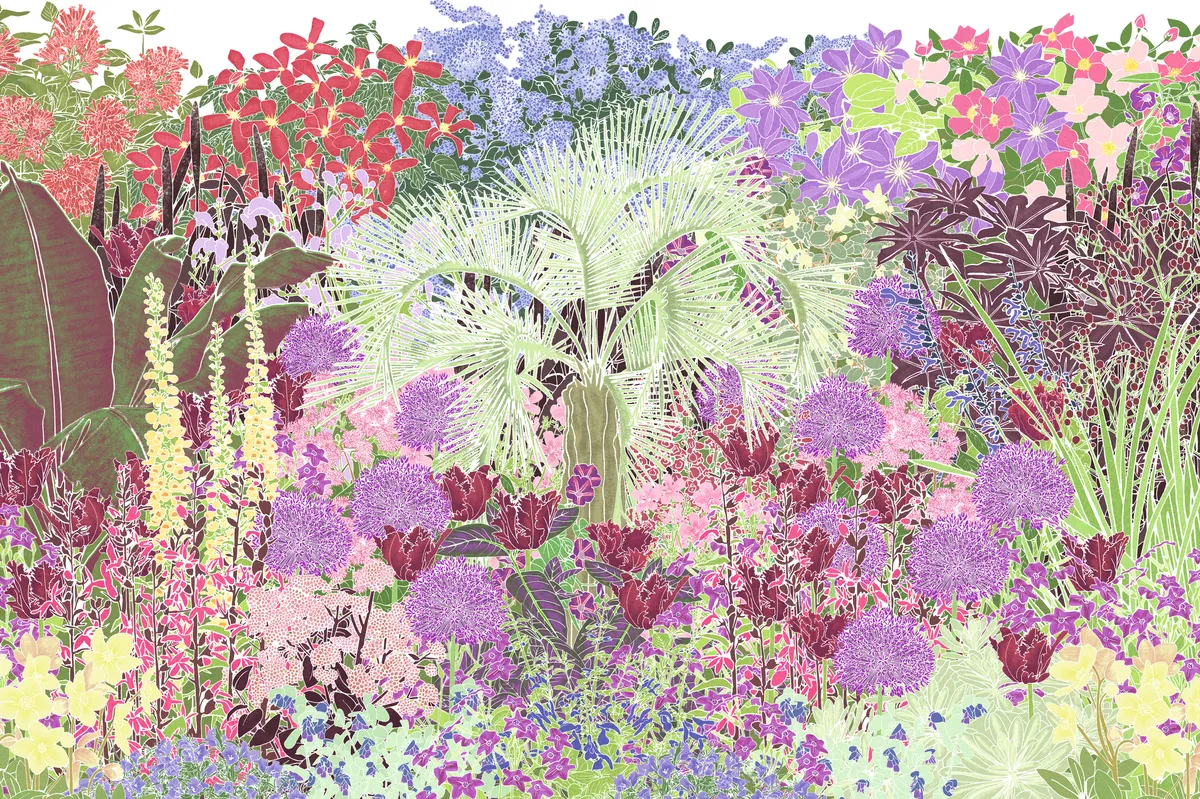The subtle charms of planting against a sheltered east-facing wall should not be underestimated. It is a position with virtues that can be put to good effect. Clear morning light will impart a vivid clarity to flower colour and leaf tone. Later, in the hottest part of the day, shade will allow the soil to retain moisture, the plants to breathe a sigh of relief and colours to be appreciated without the bleaching effect of full sun. Here is a guide by National Trust gardener Mick Evans on how to create a stunning border using half-hardy and exotic plants.
Use simple, subtle colours
This border uses a restricted palette of dusky tones; indigo-blue, magenta, plum and chocolate, played off against glaucous-metallic foliage, to work with these changing light conditions. Overall the effect is calm, but with a subtly changing mood as the day progresses. Vibrant intensity in the morning gives way to depth and mystery as the afternoon shade extends. Brooding, dusky foliage and luxuriant texture are as important as vivid flower colour. A broad range of plants – climbers, shrubs, exotics, tender perennials, bulbs and annuals – combine over a long period, from winter structure and early flowers to a dramatic peak in late summer. It is an effect that would work well against a range of backgrounds, creating a sense of depth and focus; a gentle interlude within the larger garden.
Tried and tested planting design
The design makes use of principles I have been experimenting with at Packwood House, particularly the use of colour and informal mingled planting. It also uses plants – especially tender perennials – that have performed well at Packwood in an easterly position. Planting densely, where possible with individuals rather than groups, creates an inter-woven, tapestry effect and avoids ‘blockiness’, which will slow the passage of the eye. It is exhilarating to see a plant showing its natural character and scrambling through another, presenting unplanned juxtapositions of colour and texture. Repetition also creates rhythm and cohesion. This approach allows you to build colour tone and texture throughout a planting, creating a sense of depth and intrigue.

Central to the display is the architectural presence of the giant Eryngium pandanifolium, with its towering 2.5m flower spikes, and the elegant, silver-tinged jelly palm (Butia capitata). They are joined in summer by the luxuriant Abyssinian banana, Ensete ventricosum‘Maurelii’. The Butia has an almost chameleon-like quality, its foliage seeming to take on surrounding colour. Here the steely tones in its leaves pick up the metallic quality of Helleborus x ericsmithii and Strobilanthes dyerianus. It also allows views to the wall-planting beyond, while playing host to a scrambling, maroon morning glory (Ipomoea ‘Kniola’s Black Knight’). A backdrop of wall shrubs and Clematis starts in spring with the indigo haze of Ceanothus ‘Puget Blue’, followed by the copper-toned, brick-red and pink flowers of Rosa x odorata ‘Mutabilis’ and later the ruby flowers of Cestrum newellii. In the mid ground silhouettes of tender Ricinus ‘New Zealand Black’ (sometimes sold under the name ‘New Zealand Purple’) and millet Panicum miliaceum ‘Purple Majesty’ stand in relief, emphasising colour beyond. Textural interest comes from the velvety, claret foliage of Bartlettina sordida and Euphorbia characias ‘Portuguese Velvet’ spreading through the lower tier. Splashes of magenta and rich plum, from Lobelia x speciosa ‘Tania’ and Penstemon ‘Rich Ruby’, lift the brooding tone while salvias provide a hit of electric blue.
A seam of Nictotiana x sanderae ‘Perfume Deep Purple’ threads through the planting, echoing earlier alliums. In the foreground smaller annuals and perennials pick up colours in the main planting. The scheme includes several plants that are slightly tender. The Cestrumand Correa are both worth experimenting with against a sheltered wall, as they provide such a long season of flower. The Correa’s delicate creamy flowers are carried throughout the winter months.
How to maintain an exotic border
Close planting like this is not low-maintenance gardening – it will need constant fettling to keep the balance. Tender perennials and annuals add to the work, but are worth it for the drama and freshness they provide into autumn. They should be planted out in May, after the last frosts. A winter mulch ensures fertility, while the shade and damper soil will encourage them to settle in quickly and grow well. Lifted and over-wintered in a frost-free greenhouse, tender perennials will make even more impressive specimens for the following year. The Salvia, Eupatorium, Strobilanthes and Penstemon can all be easily increased by cuttings in late summer. The Ipomoea, Panicum, Ricinus and Cerinthe can be sown from February. My approach to border design is always triggered by the site and its surroundings. Sometimes less obvious situations and plant groupings provide the impetus to make something really special. There is nothing more exciting than finding just the right plant to flourish in a particular position.
Click the link below to download a PDF of the border plan
Mick Evans is head gardener at Packwood House, Lapworth, Warwickshire B94 6AT.
Tel 01564 783294, www.nationaltrust.org.uk
Illustration by Hannah McVicar
